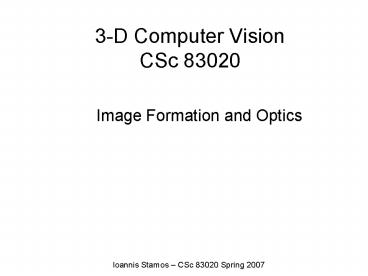3D Computer Vision CSc 83020 PowerPoint PPT Presentation
Title: 3D Computer Vision CSc 83020
1
3-D Computer VisionCSc 83020
- Image Formation and Optics
2
Image Formation Optics
- Image 2D projection of a 3D scene.
- We need to understand Geometric Radiometric
relations between the scene and its image.
3
Topics
- Pinhole Perspective Projection.
- Image Formation using Lenses.
- Lens Related Issues.
- Image Formation in the Eye.
- Our Visual World.
4
Pinhole the Perspective Projection
(x,y)
SCREEN
SCENE
Is there an image being formed on the screen?
5
Pinhole Camera
- Camera obscura known since antiquity
6
Perspective Camera
From Trucco Verri
r
r
(x,y,z)
(X,Y,Z)
Center of Projection
r x,y,zT rX,Y,ZT
r/fr/Z
xf X/Z yf Y/Z zf
f effective focal length distance of image
plane from O.
7
Magnification
From Trucco Verri
(x,y)
(X,Y,Z)
d
Center of Projection
d
(xdx,ydy)
(XdX,YdY,Z)
(xdx)/f(XdX)/Z (ydy)/z(YdY)/Z
dx/fdX/Z dy/fdY/Z
x/fX/Z y/fY/Z
gt
8
Magnification
From Trucco Verri
(x,y)
(X,Y,Z)
d
Center of Projection
d
(xdx,ydy)
(XdX,YdY,Z)
Magnification md/df/Z or
mf/Z m is negative when image is inverted
9
Magnification
- Area(image)/Area(scene)?
- m can be assumed to be CONSTANT
- if range of scene depth (?Z) is much smaller
- than average scene depth (Z).
10
Implications For Perception
Same size things get smaller, we hardly notice
Parallel lines meet at a point
A Cartoon Epistemology http//cns-alumni.bu.edu
/slehar/cartoonepist/cartoonepist.html
11
Vanishing Points
(from NALWA)
12
Consequences Parallel lines meet
- There exist vanishing points
Marc Pollefeys
13
Vanishing points
VPL
H
VPR
VP2
VP1
Different directions correspond to different
vanishing points
VP3
Marc Pollefeys
14
Question
- How many vanishing points are there in an image?
15
Approximations
- Linear approximation to perspective equations.
- Orthographic (m1 gt xX, yY).
16
Approximations
- Linear approximation to perspective equations.
- Weak-Perspective m is CONSTANT.
- xfX/Z ? fX/Zavg (Zavg average distance of
points from camera) - yfY/Z ? fY/Zavg
- Possible when Zavg is much smaller than ?Z
(relative distance of points along the optical
axis).
17
Weak-Perspective Cont.
From Trucco Verri
OBJECT POINTS
Zavg
Zavg average distance of points along the
optical axis.
18
Approximations
Weak Perspective
Para Perspective
19
Pictorial Comparison
Weak perspective
Perspective
?
Marc Pollefeys
20
Problems with Pinholes
- Pinhole size (aperture) must be small.
- The smaller the size, the less light goes
through. - If pinhole is comparable to wavelength ? of light
DIFFRACTION effects blur image. - Pinhole diameter d2sqrt(f?) for sharp images
- If f50mm and ?600nm (red light) then d0.36mm.
21
Pinhole cameras
22
Lenses
Used to avoid problems associated with
pinholes. Ideal Lens Same projection, but
gathers more light!
From Trucco Verri
f point of convergence of rays that come from
infinity.
23
Thin Lens Projection
optical axis
Image plane
z
f
Spherical lense surface Parallel rays are
refracted to single point
24
Thin Lens Projection
optical axis
Image plane
z
f
f
Spherical lense surface Parallel rays are
refracted to single point
25
Thin Lens Properties
- Any ray entering a thin lens parallel to the
optical axis must go through the focus on other
side - Any ray entering through the focus on one side
will be parallel to the optical axis on the other
side
26
Lenses
Used to avoid problems associated with
pinholes. Ideal Lens Same projection, but
gathers more light!
Ray of light
Optical Axis
From Trucco Verri
27
Lenses
Gaussian Lens Formula for thin lenses 1/ 1/
1/f Zf, zf f focal length of lens
ability to bend light
Ray of light
Optical Axis
From Trucco Verri
Example if f50mm, 300mm, then image
distance 60mm.
28
Blur Circle (Defocus)
IMAGE PLANE
APERTURE
Blur Circle w/ diameter b
P
p
d (aperture)
OPTICAL AXIS
29
Blur Circle (Defocus)
IMAGE PLANE
APERTURE
Blur Circle w/ diameter b
P
p
d
OPTICAL AXIS
3D SCENE
30
Blur Circle (Defocus)
IMAGE PLANE
APERTURE
Blur Circle w/ diameter b
OPTICAL AXIS
3D SCENE
31
Blur Circle (Defocus)
IMAGE PLANE
APERTURE
Blur Circle w/ diameter b
P
p
d (aperture)
OPTICAL AXIS
32
b?
1/ 1/ 1/f 1/ 1/ 1/f
f/(-f) f/(-f)
(- )f/(-f)f/(-f)(- )
Blur Circle Diameter b - d /
(from similar triangles) ----------------------
--------------------------------------------------
--- Depth of Field Range of object distances (-
) over which image is sufficiently well
focused. i.e. b is less than resolution of
imaging sensor. Note that b is proportional to d
(aperture).
33
Aperture DOF
d
(From KODAK)
34
Blur Circle (Defocus)
IMAGE PLANE
APERTURE
Blur Circle w/ diameter b
P
p
d (aperture)
OPTICAL AXIS
35
Focusing
- Defocused image can be made focused by
- Moving image plane.
- Moving the lens.
- Both as a single unit.
36
Two Lens System
From Shree Nayars notes
2
1
2
1
Magnification mx/x(i2/o2)(i1/o1) Zooming
Varying magnification without moving object or
image plane. Example Move LENS2 to
change m and then move LENS1 and LENS2 together
to re-focus. ZOOMINGCHANGING EFFECTIVE FOCAL
LENGTH
37
Thick Lens
From Horn
38
Vignetting
From Horn
39
Vignetting
Effect Darkens pixels near the image boundary
40
From Shree Nayars notes
41
Distortion
- magnification/focal length different
- for different angles of inclination
pincushion (tele-photo)
barrel (wide-angle)
Can be corrected! (if parameters are know)
Marc Pollefeys
42
Chromatic Aberration
rays of different wavelengths focused in
different planes cannot be removed
completely
Marc Pollefeys
43
Image Formation in the Eye
- Optics in the Eye Iris, Lens, Retina
- Defects in the Eyes Lens
- Myopia (Near-Sighted)
- Hyperopia (Far-Sighted)
- Accomodation (Focusing)
44
(No Transcript)
45
THE HUMAN EYE!
46
(No Transcript)
47
(No Transcript)
48
(No Transcript)
49
(No Transcript)
50
Our Visual World
- Image Formation 3D gt 2D
- Can we recover 3D Scene from 2D Image?
- We live in a special world!
- Medium (Air) Transparent Homogeneous.
- Objects Opaque Reflective.
- We need to recover surfaces, not volumes.
- Is one image enough?

